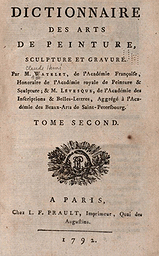 You always would have loved to own a copy of Le peintre graveur (1818) by Adam Bartsch or the Dictionnaire des arts de peinture, sculpture et gravure by Claude-Henri Watelet (1792)? What about a PDF version of Notices of engravers and their works, the commencement of a dictionary which it is not intended to continue (what a lovely title!) by William Young Ottley (1831)? Now you can download scanned versions of these treasures for free, thanks to the Google Book Search project.
You always would have loved to own a copy of Le peintre graveur (1818) by Adam Bartsch or the Dictionnaire des arts de peinture, sculpture et gravure by Claude-Henri Watelet (1792)? What about a PDF version of Notices of engravers and their works, the commencement of a dictionary which it is not intended to continue (what a lovely title!) by William Young Ottley (1831)? Now you can download scanned versions of these treasures for free, thanks to the Google Book Search project.
Google Book Search is a treasure trove for finding scanned versions of historical, important and otherwise not easily viewable standard books on engravings, etchings and the artists. It allows you to search for any keywords (author, title etc.) in the digital repository of scanned books. If the book is in the public domain and thus not under copyright anymore, you can download a PDF version to your local disk for free. Don’t forget to tick the “Full view option” when entering the keywords. Here are some links to books i have found so far, you will find many more:
- Karl Heinrich von Heinecken: Idée generale d’une collection complette d’estampe(1771)
- Claude-Henri Watelet: Dictionnaire des arts de peinture, sculpture et gravure (1792)
- T.C. Hansard: Typographia: An Historical Sketch of the Origin and Progress of the Art of Printing (1825)
- Johann Conrad Stellwag: Monogrammenlexicon für den Hausgebrauch (1830)
- William Young Ottley: Notices of engravers and their works, the commencement of a dictionary which it is not intended to continue (1831)
- Georg Kaspar Nagler: Neues allgemeines Künstler-Lexicon (1835)
- Adam von Bartsch, Joseph Heller, Rudolph Weigel: Le peintre graveur (1925)

I am a layman insofar as the art world is concerned, but I do enjoy seeing the magical works of art from ancient times. I was given a book a number of years ago entitled ‘The Portfolio’ An Artistic Periodical – Edited by Philip Gilbert Hamerton – ‘WITH NUMEROUS ILLUSTRATIONS’. London SEELEY, JACKSON, HALLIDAY, FLEET STREET 1881.
The illustrations in this book, which are of a much heavier weight of paper than those with the text, number around at least 50 – 60.
I find them to be very beautiful and they give me much satisfaction. However, my query is, are these ‘Illustrations of any value were they taken from the book and framed?
One of the ‘illustrations’ is described as follows on the ‘fly-leaf’;
St. Jerome.By Albert Durer. Reproduced bu Armand Durand -Also –
‘GLASS BLOWING’ Etched by G.P. Jacomb Hood.
to name but two.
Your comments would be greatly appreciated.
Paul Austin
London UK
Thank you for your interesting comment. I wasn’t aware of “Portfolio” by Philip Gilberton Hamerton before. The illustrations in this book are photogravures or heliogravures, used at that time for accurate reproductions of etchings and drawings. As this, they are not proofs from the original plates, but photomechanic facsimiles.
Amand-Durand (or Armand Durand, as he is often called), was a well known French engraver and etcher in the 19th century. He produced numerous etchings after old masters, like Dürer and Rembrandt, where he meticulously re-produced their most celebrated works.
I would strongly advise to leave this nice book intact; as a whole it is much more worth than single illustrations (although i understand it may be tempting to frame some of those). Well preserved copies can realize respectable prices, see
here for some examples.
Concerning the other artist mentioned, George-Percy Jacomb Hood was an etcher born in 1857 and mainly active in London (Arthur Hind, Engraving & Etching, p. 448).